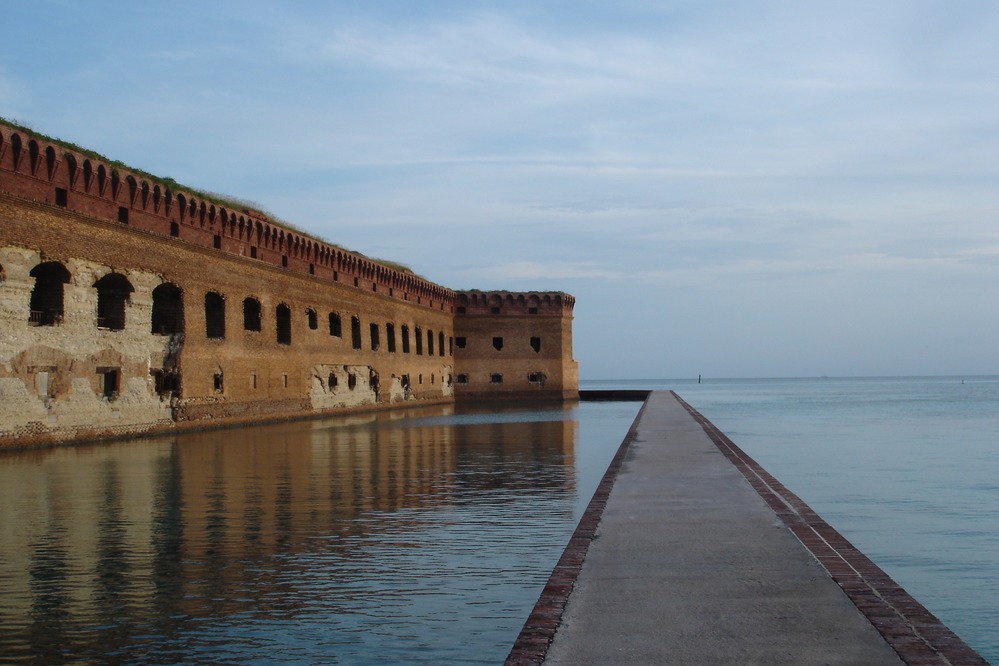Ready to explore? Check out Dry Tortugas! It’s the most remote US National Park. Clear waters, amazing wildlife, and historical landmarks — there’s something for everyone. Don’t miss out! Dive in and discover the unique wonders of Dry Tortugas. You won’t regret it!
Introduction
Discover the captivating paradise of Dry Tortugas National Park. Its rich marine life, historical forts, and pristine beaches are sure to astound you! Take a dip in the turquoise waters and explore vibrant coral reefs. Uncover the park’s hidden gems and immerse yourself in its natural wonders. Don’t forget to bring your snorkeling gear for an unforgettable underwater adventure!
Want to know more? Location and History: Dry Tortugas National Park. Where the only thing fishier than its history is the smell of the ocean!
Location and History
Dry Tortugas National Park – located 70 miles west of Key West, Florida in the Gulf of Mexico – boasts a history rich in both beauty and antiquity. In the 16th century, Spanish explorers stumbled upon these islands, dubbing them ‘Las Tortugas’ due to the abundance of sea turtles. As time passed, the US recognized its strategic importance and constructed Fort Jefferson – using 16 million bricks!
Today, visitors may explore this historical fortress and partake in activities such as snorkeling, bird watching, and camping on the pristine beaches. But remember: due to its remote location, plan ahead and book ferry services from Key West in advance. And don’t forget your gear! The crystal clear waters offer incredible visibility of coral reefs and marine life.
Geography
Dry Tortugas National Park awaits with its unique geographical features! Marvel at the seven islands, turquoise waters and vibrant coral reefs. Behold the 19th century coastal fortress, Fort Jefferson, situated on Garden Key. And, explore the abundance of marine life, including sea turtles and colorful tropical fish.
Snorkel in the clear blue waters to witness the breathtaking coral reefs. Camp under the stars on one of the park’s remote campsites. Take a guided tour of Fort Jefferson to discover its captivating past. Or, indulge in birdwatching and observe the wide variety of bird species that inhabit the park.
Sweat like a pig and treat yourself to that extra large ice cream at Dry Tortugas National Park. Embrace the unique geography and experience the wonders that await in this extraordinary destination.
Climate
The climate at Dry Tortugas National Park is diverse and unique. It has hot and humid summers, and cooler winters. The average high temperature in January is 75°F, and the average low is 64°F. There is an average precipitation of 1.4 inches.
Rain showers and dry spells make the weather unpredictable. Marine-related factors in the Gulf of Mexico influence the climate too.
Why go to a botanical garden when you can visit Dry Tortugas? See cacti and reptiles in their natural environment. Enjoy Mother Nature’s desert chic!
Flora and Fauna
Dry Tortugas National Park is situated in the Gulf of Mexico and is home to an array of unique flora and fauna. Seagrasses, mangroves, and hardwood trees are just some of the plant life found here. Bird-watchers, rejoice! Over 299 species of birds have been spotted on the islands. Magnificent frigatebirds, brown pelicans, and sooty terns make an appearance. Don’t forget about the vibrant marine life, like parrotfish and angelfish.
Fort Jefferson, a grand coastal fortification, is located within the park’s boundaries. This 19th century landmark offers visitors a chance to explore its fascinating history. All while being surrounded by the park’s remarkable biodiversity.
So get ready to be amazed by the captivating beauty of Dry Tortugas National Park – an environment where even the fish struggle to find a dry spot!
Ecosystem
Dry Tortugas National Park’s ecosystem is a complex blend of plants, animals, and habitats. These range from terrestrial, marine, and coastal environments.
Terrestrial areas consist of small islands with sparse vegetation such as cacti and shrubs. Marine zones are abundant in coral reefs, seagrass beds, and mangrove forests. Coastal regions provide nesting grounds for sea turtles and shorebirds in sandy beaches and dunes.
The park not only has unique biodiversity, but also is essential in maintaining ecological balance. Its coral reefs serve as home to numerous fish species, benefiting both the local ecosystem and recreational activities.
To preserve this delicate ecosystem, visitors must follow certain guidelines. Firstly, avoid littering or leaving any trash behind – marine debris can harm wildlife and pollute the water. Secondly, respect the park’s designated trails – this protects sensitive plants and prevents soil erosion. Lastly, do not disturb or feed wildlife – this allows them to follow their natural behaviors and prevents dependency on human food sources.
By following these suggestions, visitors can aid in the long-term sustainability of Dry Tortugas National Park while savoring its beauty responsibly. This incredible park is a shining example of conservation in an ever-evolving world!
Conservation
Conservation is key in Dry Tortugas National Park. It is dedicated to preserving its special ecosystem and safeguarding the variety of plants and animals. Through management and teaching, the park intends to guarantee the long-term survivability of this marvelous place. This park shows the need to protect our planet’s beauty and biodiversity with its beautiful beaches, coral reefs, and historic Fort Jefferson.
Exploring conservation in Dry Tortugas National Park further, there is a range of endangered species. From sea turtles to migratory birds, they depend on the protected environment for their lives. The park abides by strict regulations to protect these vulnerable species.
A point of interest about conservation in Dry Tortugas National Park is research and monitoring. Scientists and researchers study water quality and marine life numbers, providing info for conservation. This dedication to research lets us understand the ecosystem’s health and helps with conservation decisions.
Pro Tip: When visiting Dry Tortugas National Park, remember you can make a difference. Respect the environment by following Leave No Trace principles, respecting wildlife habitats, and following park rules. Together, we can all contribute to preserving this amazing natural treasure. Looking for some fun? You don’t need a snorkel!
Recreation
Dry Tortugas National Park has it all – adventure, relaxation, and educational experiences! Let’s take a look at the many recreational activities it offers.
Snorkeling is available at Garden Key. Scuba diving can be done at Loggerhead Key. Camping overnight is possible at Long Key. Birdwatching is best at Bush Key. Stargazing under the park’s clear night skies is also possible.
Here are some tips to help you get the most out of your visit:
- Pack your own snorkel gear or rent it from an authorized vendor.
- Certified divers should explore Loggerhead Key’s underwater ecosystem.
- Campers should enjoy the tranquility of Long Key’s coastal views.
- Birdwatchers should bring binoculars to Bush Key.
So come and experience Dry Tortugas National Park – it will captivate your senses like never before! Don’t forget to pack sunscreen and a shovel for all that buried treasure!
Tourism
Touring Dry Tortugas National Park provides a great chance to discover its untouched beauty and past. Snorkelers and divers will appreciate the diverse marine life and enthralling coral reefs. And, you can explore Fort Jefferson, a reminder of its interesting history.
You’ll find peace in the park’s remote location away from the buzz of the city. This tranquil atmosphere permits visitors to really connect with nature’s wonders. Hiking trails present stunning views, while birdwatchers can spot rare birds.
To make the most of your visit, camp overnight at one of the park’s campgrounds. This enables you to completely take in the natural beauty and view the picturesque sunsets over the cobalt waters.
It’s a good idea to join a guided tour, too. Guides can give you information about the park’s history, ecology, and conservation activities. Also, they’ll direct your attention to special hidden gems and answer your questions.
In conclusion, tourism in Dry Tortugas National Park is an amazing expedition packed with exploration, tranquillity, and admiration for our natural environment. Whether you’re a fan of the outdoors or history, this unique spot has something for everyone. So, start packing for a remarkable journey that’ll create lasting memories. And, who knows, maybe in the future they’ll install a swim-up bar at Fort Jefferson for margaritas with a side of history!
Future
The future of Dry Tortugas National Park is full of possibilities. Conservation is helping the Florida Keys gem thrive, so it can stay gorgeous for many years.
New projects are improving the park’s beauty and looking after the environment. Research will help make sure the wildlife and oceans are safe.
Local communities are also part of the plan. People of all backgrounds are being invited to help protect the park.
Nowadays, tech offers different ways to explore the park. Virtual reality tours are available, so people who can’t travel can still experience the amazing sights and creatures.
Don’t miss out! Nature lovers and those needing a break can discover this secret paradise of blue waters and sunny beaches. Let’s work together to make a better tomorrow for Dry Tortugas National Park.
FAQ
What is Dry Tortugas National Park?
Dry Tortugas National Park is a remote national park located in the Gulf of Mexico, about 70 miles west of Key West, Florida. It is known for its crystal-clear waters, vibrant coral reefs, and the historic Fort Jefferson.
How can I get to Dry Tortugas National Park?
The only way to reach Dry Tortugas National Park is by boat or seaplane. The park can be accessed from Key West through various charter companies that offer guided tours or transportation services.
Can I camp at Dry Tortugas National Park?
Yes, camping is allowed at Dry Tortugas National Park. The park offers a primitive camping experience on Garden Key, where you can pitch a tent and enjoy the stunning views and tranquility of the remote island. Advanced reservations are required for camping.
What activities can I do at Dry Tortugas National Park?
Visitors to Dry Tortugas National Park can engage in a variety of outdoor activities. These include snorkeling, scuba diving, birdwatching, fishing, exploring the fort, and simply relaxing on the beautiful sandy beaches.
Are there facilities available at Dry Tortugas National Park?
While the park offers basic facilities such as restrooms and picnic areas, it is important to note that there are no food or water services available on the islands. Visitors are encouraged to bring their own supplies and pack out any waste.
What is the best time to visit Dry Tortugas National Park?
The best time to visit Dry Tortugas National Park is during the dry season, which typically runs from November to April. The weather during this period is more favorable with calm seas, making it ideal for outdoor activities like snorkeling and diving.




Leave a Reply